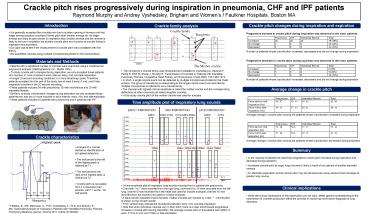Crackle pitch rises progressively during inspiration in pneumonia, CHF and IPF patients - PowerPoint PPT Presentation
1 / 1
Title:
Crackle pitch rises progressively during inspiration in pneumonia, CHF and IPF patients
Description:
Crackle pitch rises progressively during inspiration in pneumonia, CHF and IPF patients Raymond Murphy and Andrey Vyshedskiy, Brigham and Women s / Faulkner ... – PowerPoint PPT presentation
Number of Views:55
Avg rating:3.0/5.0
Title: Crackle pitch rises progressively during inspiration in pneumonia, CHF and IPF patients
1
Crackle pitch rises progressively during
inspiration in pneumonia, CHF and IPF
patients Raymond Murphy and Andrey Vyshedskiy,
Brigham and Womens / Faulkner Hospitals, Boston
MA
Introduction
- It is generally accepted that crackles are due
to sudden opening of airways and that larger
airways produce crackles of lower pitch than
smaller airways do. As larger airways are likely
to open earlier in inspiration than smaller
airways and the reverse is likely to be true in
expiration we studied crackle pitch as a function
of crackle timing in inspiration and expiration. - Our goal was to see if the measurement of
crackle pitch was consistent with this theory. - We quantified crackles using multiple
microphones placed on the chest surface .
Progressive increase in crackle pitch during
inspiration was observed in the most patients
Pneumonia CHF Interstitial fibrosis Total
Increased 28 28 23 79 (79)
No change 2 6 2 10 (10)
Decreased 4 4 3 11 (11)
Number of patients whose crackle pitch increased,
decreased and did not change during inspiration.
Progressive decrease in crackle pitch during
expiration was observed in the most patients
- Patients with a significant number of crackles
were examined using a multichannel lung sound
analyzer (Stethographics, Inc., Model 1602). - To study crackle pitch changes during
inspiration, we only accepted those patients who
had two or more crackles in each interval early,
mid, and late-inspiration. - A single 20 second recording contained 3 or more
breathing cycles. Therefore, patients accepted
into this part of the study had at least 6 early,
6 mid, and 6 late-inspiratory crackles in the 20
second recording. - These patients included 34 with pneumonia, 38
with heart failure and 28 with interstitial
fibrosis. - Similarly, to study crackle pitch changes during
expiration we only accepted those patients who
had two or more crackles in each interval early,
mid, and late-expiration. - These patients included 10 patients with
pneumonia and 8 patients with IPF.
Pneumonia CHF Interstitial fibrosis Total
Increased 0 0 0 0 (0)
No change 3 0 2 5 (28)
Decreased 7 0 6 13 (72)
- The concept of a crackle family was introduced
and validated in Vyshedskiy A, Bezares F, Paciej
R, Ebril M, Shane J, Murphy R. Transmission of
Crackles in Patients with Interstitial Pulmonary
Fibrosis, Congestive Heart Failure, and
Pneumonia. Chest 2005 1281468-1474. - In short, a single crackle event can be detected
by multiple microphones located on the chest
surface. The group of waveforms corresponding to
the single crackle event and recorded by multiple
microphones is referred to as a crackle family. - The channel with highest crackle amplitude is
called the mother crackle and the corresponding
deflections at other channels are called daughter
crackles. - In this study crackle pitch of the mother
crackle was used for analysis.
Number of patients whose crackle pitch increased,
decreased and did not change during expiration.
Pneumonia CHF Interstitial fibrosis Total
From early to mid-inspiration (Hz) 4647 4355 4046 4249
From mid to late-inspiration (Hz) 4945 5745 3841 4844
EARLY INSPIRATION
MID-INSPIRATION
LATE INSPIRATION
Average change in crackle pitch among the
patients whose crackle pitch increased during
inspiration.
286Hz
235Hz
313Hz
231Hz
320Hz
500Hz
526Hz
372Hz
Pneumonia CHF Interstitial fibrosis Total
From early to mid-expiration (Hz) 7440 N/A 1717 5343
From mid to late expiration (Hz) 3748 N/A 4915 4336
Average change in crackle pitch among the
patients whose crackle pitch decreased during
expiration
- Analysis of a crackle started by identification
of its highest deflection. - The half period to the left of the highest peak
is referred as T1. - The half period to the right of the highest peak
is marked as T2. - Crackle pitch is calculated from 4 consecutive
half periods, with T1 as the 1st half period.
163Hz
303Hz
300Hz
353Hz
308Hz
444Hz
296Hz
- In the majority of patients we observed
progressive crackle pitch increase during
inspiration and decrease during expiration. - Increased crackle pitch at larger lung volumes
is likely a result of recruitment of smaller
diameter airways. - An alternate explanation is that crackle pitch
may be influenced by airway tension that
increases at greater lung volume.
- A time amplitude plot of inspiratory lung
sounds recorded from a patient with pneumonia. - Channels 1 to 7 were recorded from the right
lung, channels 9 to 15 were recorded from the
left lung, channel 8 was recorded from the heart
(not used for crackle analysis), channel 16 was
recorded from the trachea (not used for crackle
analysis). - A black border indicates crackle families,
mother crackles are marked by a star , crackle
pitch is shown on top of each border. - Thick vertical lines indicate the boundaries
between early, mid, and late-inspiration. - Note that while individual crackles vary in
their pitch, there is a clear trend toward
progressive increase in crackle pitch during
inspiration the average crackle pitch in this
patient was 269Hz in early, 317Hz in mid, and
376Hz in late-inspiration.
- While the clinical implications of this
observation are not clear, better general
understanding of the mechanism of crackles
production offers the promise of improving
noninvasive diagnosis of lung disorders.
- Flietstra, B., MS, Markuzon, N., PhD,
Vyshedskiy, A., PhD, and Murphy, R.,
MD. Automated Analysis of Crackles in Patients
with Interstitial Pulmonary Fibrosis. Pulmonary
Medicine Journal, Volume 2011, Article ID 590506,































